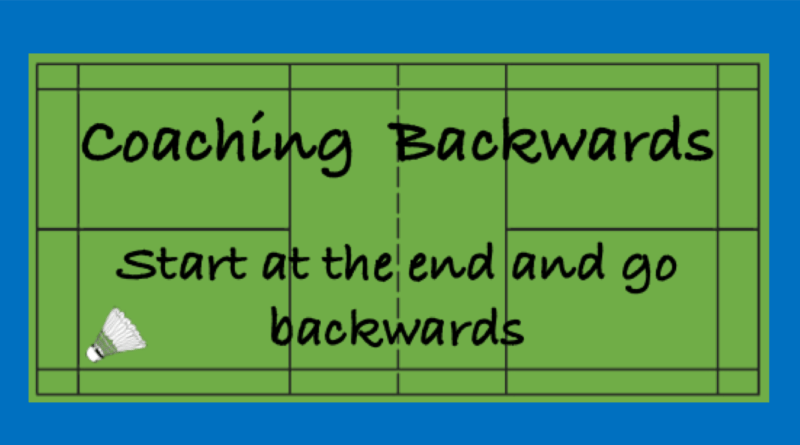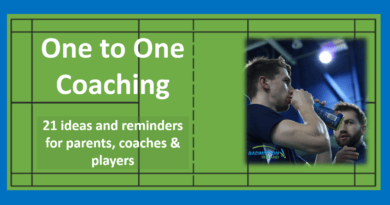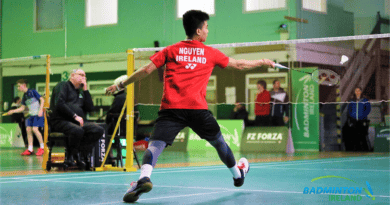How I learnt to coach backwards
The day I was handed this 2 sided document changed how I coached
I started to find easier ways for my players to improve a range of strokes and movements on court. I learnt a new skill, to coach backwards.
Instead of starting at the beginning of the stroke or movement, I started at the end, just before impact.
This post is based on the a paper called “Backward Chaining Teaching Method of Motor Skills” by P Chekkadurai & C Stothart 1978. The man who gave it to me was Roger Mills, my dear friend and mentor.
If you want to read the paper before listening to my thoughts then click the link above. The copy still has Rogers hand written comments. I make no excuse for that, in fact I think it added to my understanding.

– – – – – – – – – – – – – – – – – –
Backward Chaining Teaching Method
Backward chaining does work
The immediate improvements
Advantages of using Backward Chaining
Questions .. Where would you start?
– – – – – – – – – – – – – – – – – –
Backward Chaining Teaching Method
This is one of the most useful papers I have read. It recommends teaching new skills by starting at the ‘end’ of a sequential set of component parts. The Backward Chaining Teaching Method.
I am not a sports scientist and there are many things I don’t understand. It may surprise some of my friends to hear that I’m not interested in exactly how and why some teaching/coaching methods work better than others.
What really does excite me is when something works and works with a variety of players…… now that really excites me !
The methods included in this paper and the way they can be applied to Badminton really do make a difference
– – – – – – – – – – – – – – – – – –
Backward chaining does work
It is a very effective teaching method in developing technical skills ; hitting and moving
I’ve used backward chaining in the coaching of a range of strokes, especially when movement is included. Using this concept can be very game-like. For me it’s very important not to separate striking and moving. If fact many striking actions benefit if they combined with a movement. Backward chaining has at its core the fact that one part of a skill follows directly into an other and that can have a big influence of the next ‘link’. I hope my sport scientist friends don’t jump on me for using the word skill in this way.
Backward chaining can be used with skills that involve small movements (single step) or slighter larger (long jump lunge / chasse approach). It can also be used for strokes that contain bigger movements such as running and / or jumping. There is a certainly a different coaching philosophy /methodology between using backward chaining and ‘static practice’ as some coaches call it.
I’ve also used backward chaining in the teaching of some ‘complex’ hitting skills such as the overhead backhand. My understanding only came after many hours of working with Roger and trying it out on court. Reading about the methodology only part prepared me. My coaching delivery plus my reflection, that was full of trail and error, eventually gave me the confidence to know that this works!
– – – – – – – – – – – – – – – – – –
The immediate improvements
The first area I found that helped my players was when they were improving their net shots when combined with a movement towards the forecourt. I managed to make practices more like games: have variability in feeding, hit lots of shuttles, easily made the practice ‘tougher’ without necessarily increasing errors. Most of all the players were coping. Improvements seem faster and when things went wrong the first step was to take away the last element introduced.
By taking away the last introduced element it gave both me and the player an opportunity to repeat the last few minutes and hopefully get that back to the successful outcomes. The benefit was it it still felt like we were practising the stroke/ movement but now the success level increased.
In time I realised that the players were benefitting from learning new elements at the start of the practice and working towards previously learnt (or part learnt) ones. Rather than my previous approach of introducing new elements at the end of previously learnt ones.
Strokes and moments
These are the on court strokes and situations that I find easily benefit from using Backward Chaining
— All forecourt net work (nets & lifts/flick) with a variety of forward movements (Step / Jump Lunge / Chasse / Running)
— Deep Forehand (drag)
— Overhead backhand strokes (long drops & clears)
— Some parts of the Overhead forehand
In all of these examples, I recommend that you start from just before the contact and then work backwards. You may need to amend the hitting action and body position to re-create that moment before striking.
– – – – – – – – – – – – – – – – – –
Advantages of using Backward Chaining
- There is lots of ‘end skill’ reinforcement
- The last element (the hit) is continually worked on and reinforced therefore the method is high in positive reinforcement and accomplishment of task
- The introduction of new elements in a stroke or movement is always followed by previously ‘mastered’ and successful elements
- If a technique/movement starts to breakdown then take away the new elements and repeat with the previously successful outcomes
- The player is striking shuttles on every attempt. Less reliance on shadow work for learning
- Confidence through success is easier to achieve
– – – – – – – – – – – – – – – – – –
Questions .. Where would you start?
1 . How do you coach (improve) both net skills and the approach movements at the same time?
2 . Do you separate movement and striking in your coaching?
3 . How can you start part way through a complex stroke but still retain game like feelings and outcomes?
These were all the questions I faced before I read this paper. Then I became more familiar with the theory and it’s aspects of ‘positive terminal reinforcement’ and ‘temporal patterning”.
– – – – – – – – – – – – – – – – – –
What do you do?
Do you start around the mid court them move forward? – teaching movement patterns without striking. If you follow this process how do you ensure that the players are still able to hit lots of shuttles and how do you keep them motivated?
or
Do you start in the forecourt with a single step net? – mastering the contact from simple controlled feeds. If you follow this process how do you introduce game-like movements and ability to cope with different feeds?





First I will start from rear court, only with the stroke with the player body turn around,then I will make them do the movement of the body rotation, next step would be racket feeding with the player recovering to the service line, last one I will feed two shuttles one net the other back court.